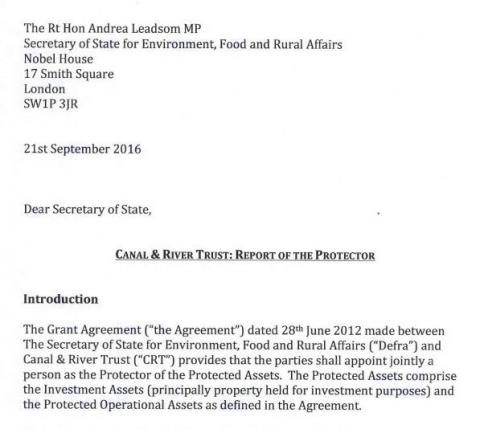C&RT's financial protector report surfaces
February 2017 - By Allen Richards
Whenever the Canal & River Trust goes quiet about something it is a pretty sure sign all is not well and Allan Richards has had to make a Freedom of Information request followed by request for a review when refused, before a key independent report on C&RT finances saw the light of day.
A year ago, C&RT were celebrating. The Protector’s report for their 2014/15 financial year gave their investment performance a clean bill of health. Indeed, on December 4 2015, they issued a press release with quotes from the Protector, Malcolm Naish, and Property Director, Stuart Mills.
They even supplied one from the waterways minister, although it had nothing to do with their financial performance.
Just a year later, the new Protector report for financial year 2014/15 was quietly sneaked onto the C&RT website – no press release and no announcement.
The Protector is jointly appointed by DEFRA and C&RT under a Grant Agreement to monitor the management of the Trust’s investment assets.
A key aspect of his role is to monitor the Trust’s compliance with the Grant Agreement and to monitor actual or threatened ‘Material Diminution’ or ‘Material Diversion’.
In plain English, it means that he checks that the value of the Trust's assets (mostly property), does not fall over time, and is only used for the purposes defined in the agreement.
These property assets form one of the four major revenue streams for C&RT. The others are utility income (including water sales), Boating (Licences, Moorings) and Defra Grant.
That something was amiss became clear when Defra refused to provide a copy of the report. In a letter dated 18 October, DEFRA stated:
“We recognise that there is a public interest in disclosure of this information in the interest of greater transparency to the public about the accountability of the Canal & River Trust in managing the commercial property endowment received from Government on transfer.
“This accountability is provided by the Protector arrangements and there is a public interest in his report being publicly available.
“On the other hand, there is a strong public interest in withholding the information at this time because the Department has not yet fully considered the report.
“Consideration by the Department may flag up further questions we would like the Protector to explore. Therefore, we have concluded that in all the circumstances of the case, the information should be withheld at this time.”
DEFRA went on to say that the report would be published on C&RT’s website at a later date.
When C&RT did publish, it was found that the final report (actually a five page letter) was dated 21 September, some four weeks before DEFRA refused the request to provide it!
The Protector commented on C&RT’s hedging policy (sometimes known as its diversification policy).
C&RT’s rationale for adopting this policy was to not have all its financial eggs in the property market basket but move some to non-property investments as a hedge against falling property value.
However, whilst the trust was expecting a 6.64 per cent return on this investment - of over £100 million last year - it lost 3.06 per cent.
The Protector also highlighted that the rate of return on property investments was lower than the last two years and has warned of the possibility of a future diminution of value.
The Trust is already spending less than it told government on maintaining its waterways. With Grant now declining year on year and uncertainty surrounding the ability of its property assets to generate sufficient income, these are uncertain times.
What will happen it ten years’ time when the grant agreement runs out?
Photos: (Top) The report itself and (bottom) The Protector, Malcolm Naish.







